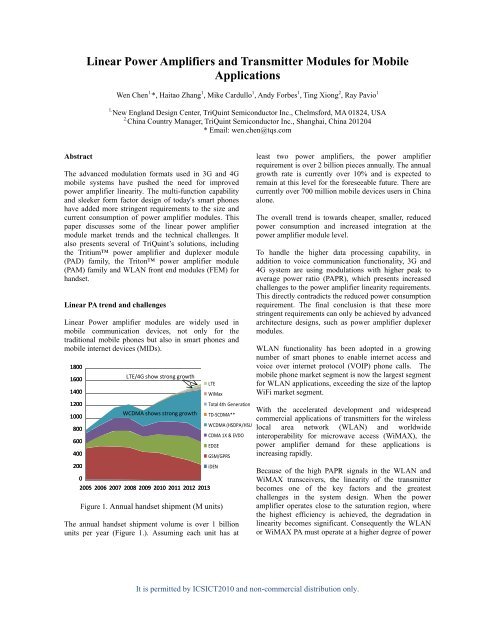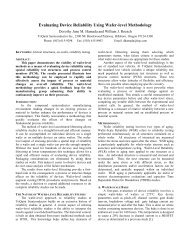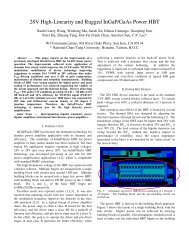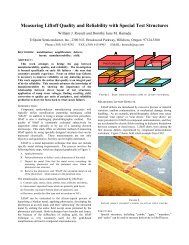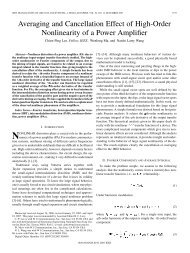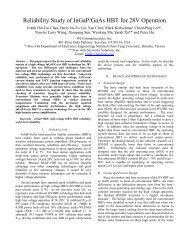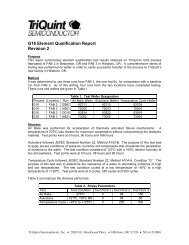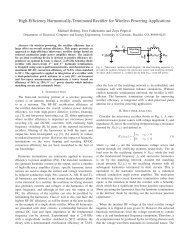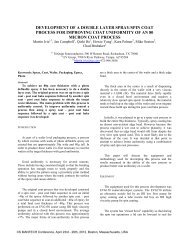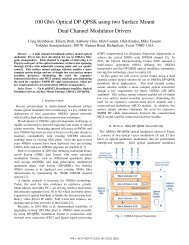Linear Power Amplifiers and Transmitter Modules for Mobile ...
Linear Power Amplifiers and Transmitter Modules for Mobile ...
Linear Power Amplifiers and Transmitter Modules for Mobile ...
Create successful ePaper yourself
Turn your PDF publications into a flip-book with our unique Google optimized e-Paper software.
Abstract<br />
<strong>Linear</strong> <strong>Power</strong> <strong>Amplifiers</strong> <strong>and</strong> <strong>Transmitter</strong> <strong>Modules</strong> <strong>for</strong> <strong>Mobile</strong><br />
Applications<br />
Wen Chen 1. *, Haitao Zhang 1 , Mike Cardullo 1 , Andy Forbes 1 , Ting Xiong 2 , Ray Pavio 1<br />
1. New Engl<strong>and</strong> Design Center, TriQuint Semiconductor Inc., Chelms<strong>for</strong>d, MA 01824, USA<br />
2. China Country Manager, TriQuint Semiconductor Inc., Shanghai, China 201204<br />
* Email: wen.chen@tqs.com<br />
The advanced modulation <strong>for</strong>mats used in 3G <strong>and</strong> 4G<br />
mobile systems have pushed the need <strong>for</strong> improved<br />
power amplifier linearity. The multi-function capability<br />
<strong>and</strong> sleeker <strong>for</strong>m factor design of today's smart phones<br />
have added more stringent requirements to the size <strong>and</strong><br />
current consumption of power amplifier modules. This<br />
paper discusses some of the linear power amplifier<br />
module market trends <strong>and</strong> the technical challenges. It<br />
also presents several of TriQuint’s solutions, including<br />
the Tritium power amplifier <strong>and</strong> duplexer module<br />
(PAD) family, the Triton power amplifier module<br />
(PAM) family <strong>and</strong> WLAN front end modules (FEM) <strong>for</strong><br />
h<strong>and</strong>set.<br />
<strong>Linear</strong> PA trend <strong>and</strong> challenges<br />
<strong>Linear</strong> <strong>Power</strong> amplifier modules are widely used in<br />
mobile communication devices, not only <strong>for</strong> the<br />
traditional mobile phones but also in smart phones <strong>and</strong><br />
mobile internet devices (MIDs).<br />
1800<br />
1600<br />
1400<br />
1200<br />
1000<br />
800<br />
600<br />
400<br />
200<br />
LTE/4G show strong growth<br />
WCDMA shows strong growth<br />
0<br />
2005 2006 2007 2008 2009 2010 2011 2012 2013<br />
Figure 1. Annual h<strong>and</strong>set shipment (M units)<br />
LTE<br />
WiMax<br />
Total 4th Generation<br />
TD‐SCDMA**<br />
WCDMA (HSDPA/HSU<br />
CDMA 1X & EVDO<br />
EDGE<br />
GSM/GPRS<br />
iDEN<br />
The annual h<strong>and</strong>set shipment volume is over 1 billion<br />
units per year (Figure 1.). Assuming each unit has at<br />
least two power amplifiers, the power amplifier<br />
requirement is over 2 billion pieces annually. The annual<br />
growth rate is currently over 10% <strong>and</strong> is expected to<br />
remain at this level <strong>for</strong> the <strong>for</strong>eseeable future. There are<br />
currently over 700 million mobile devices users in China<br />
alone.<br />
The overall trend is towards cheaper, smaller, reduced<br />
power consumption <strong>and</strong> increased integration at the<br />
power amplifier module level.<br />
To h<strong>and</strong>le the higher data processing capability, in<br />
addition to voice communication functionality, 3G <strong>and</strong><br />
4G system are using modulations with higher peak to<br />
average power ratio (PAPR), which presents increased<br />
challenges to the power amplifier linearity requirements.<br />
This directly contradicts the reduced power consumption<br />
requirement. The final conclusion is that these more<br />
stringent requirements can only be achieved by advanced<br />
architecture designs, such as power amplifier duplexer<br />
modules.<br />
WLAN functionality has been adopted in a growing<br />
number of smart phones to enable internet access <strong>and</strong><br />
voice over internet protocol (VOIP) phone calls. The<br />
mobile phone market segment is now the largest segment<br />
<strong>for</strong> WLAN applications, exceeding the size of the laptop<br />
WiFi market segment.<br />
With the accelerated development <strong>and</strong> widespread<br />
commercial applications of transmitters <strong>for</strong> the wireless<br />
local area network (WLAN) <strong>and</strong> worldwide<br />
interoperability <strong>for</strong> microwave access (WiMAX), the<br />
power amplifier dem<strong>and</strong> <strong>for</strong> these applications is<br />
increasing rapidly.<br />
Because of the high PAPR signals in the WLAN <strong>and</strong><br />
WiMAX transceivers, the linearity of the transmitter<br />
becomes one of the key factors <strong>and</strong> the greatest<br />
challenges in the system design. When the power<br />
amplifier operates close to the saturation region, where<br />
the highest efficiency is achieved, the degradation in<br />
linearity becomes significant. Consequently the WLAN<br />
or WiMAX PA must operate at a higher degree of power<br />
It is permitted by ICSICT2010 <strong>and</strong> non-commercial distribution only.
ack off from the peak output power to meet the linearity<br />
requirement, which results in degraded efficiency<br />
per<strong>for</strong>mance.<br />
To improve the power consumption at backed off power<br />
levels, most of the systems are adopting a DC to DC<br />
converter which reduces the power amplifier battery<br />
supply voltage at lower output power levels. To<br />
accommodate this functionality, the power amplifier or<br />
transmitter module should include a directional coupler<br />
or power detector, so that the system will have feedback<br />
in<strong>for</strong>mation about the output power level. With the size<br />
of the power amplifier <strong>and</strong> transmitter module getting<br />
reduced further with each generation, the inherent<br />
challenge becomes <strong>for</strong> the integrated directional coupler<br />
to have sufficient directivity so that the power detector<br />
will have less error as a result of antenna mismatch<br />
impedance.<br />
Tritium PAD family<br />
TriQuint is one of the market leaders in PA duplexer<br />
module (PAD) development. Most of the TriQuint’s PAD<br />
includes the power amplifier, duplexer, interstage TX<br />
filter, coupler <strong>and</strong> bypass capacitors in a single package.<br />
In addition, some of the Tritium modules include a<br />
power detector that mates with an appropriate transceiver.<br />
The PAD is one of the highest dem<strong>and</strong>ed product groups<br />
<strong>for</strong> TriQuint, its primary application is <strong>for</strong> smart phone<br />
module applications.<br />
In a discrete solution, additional matching components<br />
are required between the output of the power amplifier<br />
<strong>and</strong> the input of the duplexer to optimize linearity <strong>and</strong><br />
current consumption. In addition, there is also a<br />
matching circuit between the output of the interstage<br />
filter <strong>and</strong> the input of the power amplifier. These<br />
matching structures are eliminated in all of the Tritium<br />
PADs, which results in a marked reduction in the size of<br />
the overall module footprint (Figure 2.). This high<br />
level of integration also simplifies the application <strong>for</strong> the<br />
end user since the need <strong>for</strong> external matching is<br />
removed.<br />
One of the principal benefits of the PAD is the greatly<br />
improved power added efficiency (PAE), relative to that<br />
of a power amplifier module (PAM). As was previously<br />
mentioned, there is additional matching circuitry<br />
between the power amplifier <strong>and</strong> the duplexer. For a<br />
discrete power amplifier <strong>and</strong> duplexer circuit design, the<br />
output of the PA is matched close to 50 ohms, <strong>and</strong> then<br />
passes through the external matching circuit to duplexer<br />
transmit (TX) port. In addition, typically there is internal<br />
matching in the duplexer to match it to 50 ohms as well.<br />
The primary effect of this added external matching<br />
circuitry is additional loss after the power amplifier<br />
output. In order to achieve the same delivered power to<br />
the antenna, the power amplifier will have to operate at a<br />
higher output power, which will result in increased<br />
current consumption <strong>for</strong> the TX chain.<br />
TX<br />
1.5x2<br />
LC<br />
PA<br />
4x4<br />
LC<br />
Discrete solution<br />
PAD<br />
7x4<br />
PAD solution<br />
Figure 2. discrete solution versus PAD<br />
In the Tritium PAD, the power amplifier is matched to<br />
the internally developed SAW or BAW duplexer’s TX<br />
port with a single section matching network. By<br />
implementing this architecture, we can save<br />
approximately 1dB of output power, which corresponds<br />
to a reduction in current consumption of approximately<br />
20%. This is a significant savings <strong>for</strong> the mobile device<br />
battery usage, since power amplifier is the primary<br />
consumption components in the h<strong>and</strong>set.<br />
PAD<br />
8x5<br />
PAD<br />
7x4<br />
PAD<br />
Figure 3. Tritium PAD history<br />
The TriQuint Tritium PAD family history is shown in<br />
figure 3. The Tritium I family PADs, sized <strong>for</strong><br />
8mmx5mmx1.5mm, are 1-bit digital controlled PADs,<br />
have high power mode (HPM) <strong>and</strong> low power mode<br />
(LPM). The modules include an interstage filter, PA, <strong>and</strong><br />
It is permitted by ICSICT2010 <strong>and</strong> non-commercial distribution only.<br />
CPL<br />
1.5x0.75<br />
DUP<br />
2x2.5<br />
Tritium I<br />
WCDMA/CDMA PAD<br />
Tritium II, CDMA PAD<br />
Tritium III, WCDMA PAD<br />
Tritium IV, WCDMA PAD
duplexer, together with an integrated directional coupler<br />
<strong>and</strong> power detector.<br />
The Tritium II PADs, sized <strong>for</strong> 7mmx4mmx1.1mm,<br />
are 2-bit digitally controlled CDMA PADs, which have<br />
HPM, medium power mode (MPM) <strong>and</strong> LPM. The<br />
modules have interstage filter, PA, <strong>and</strong> duplexer, <strong>and</strong> the<br />
directional coupler.<br />
The TriQuint Tritium III family, also sized <strong>for</strong><br />
7mmx4mmx1.1mm, provides PAD module solutions <strong>for</strong><br />
WCDMA b<strong>and</strong>s 1, 2, 5 <strong>and</strong> 8. They utilize a 1-bit digital<br />
control <strong>for</strong> HPM <strong>and</strong> LPM, as well as an analog control<br />
<strong>for</strong> the LPM biasing to maximize the current saving at<br />
the back off power levels. They have an integrated<br />
interstage filter, power amplifier <strong>and</strong> duplexer, together<br />
with directional coupler <strong>and</strong> power detector.<br />
For example, the Tritium III WCDMA B5<br />
TQM616025 product per<strong>for</strong>mance is shown in figure 4.<br />
The high power mode (HPM) <strong>and</strong> low power mode<br />
(LPM) operate up to 25dBm <strong>and</strong> 16dBm at the Antenna<br />
port respectively. Besides the highly efficient HPM<br />
design, the LPM biasing current is extremely low at the<br />
back off power levels; there<strong>for</strong>e the back off current<br />
consumption is reduced dramatically. All of these<br />
features combine to result in a significant increase in talk<br />
time.<br />
ACLR1(dBc), Gain(dB)<br />
30<br />
500<br />
20<br />
450<br />
10<br />
400<br />
0<br />
350<br />
‐10<br />
‐20<br />
‐30<br />
ACLR1<br />
Gain<br />
Icc<br />
300<br />
250<br />
200<br />
‐40<br />
150<br />
‐50<br />
100<br />
‐60<br />
50<br />
‐70<br />
0<br />
‐15 ‐10 ‐5 0 5 10 15 20 25 30<br />
Pout (dBm)<br />
Figure 4. Tritium III B5 TQM616025 per<strong>for</strong>mance<br />
The next generation of PAD modules, the Tritium IV<br />
family, has removed the interstage filter to be compatible<br />
with the 4G system design requirements. These products<br />
are still under development.<br />
Triton 3x3 PA family<br />
The TriQuint Triton PA Module family is a group of<br />
3mm3mmx1.1mm 2-bit WCDMA power amplifiers<br />
Icc (mA)<br />
using TriQuint’s latest BIHEMT process <strong>and</strong> CuFlip ®<br />
flip chip assembly technology.<br />
The WCDMA B1, B2, B4, B5/6, <strong>and</strong> B8 power<br />
amplifiers have HPM max Pout between 28.2 dBm <strong>and</strong><br />
28.6 dBm, with PAE of approximately 40%, <strong>and</strong> a gain<br />
about 27dB. The medium power mode (MPM) <strong>and</strong><br />
LPM’s max Pout are 17dBm <strong>and</strong> 7dBm, with PAE of<br />
15% <strong>and</strong> 9%, <strong>and</strong> the gain is approximately 19dB <strong>and</strong><br />
12dB respectively.<br />
Besides the state of art linearity <strong>and</strong> PAE, this group of<br />
products also have integrated 20dB couplers, with best in<br />
class directivity.<br />
TriQuint’s new BiHEMT process provides a full<br />
integration of HBT <strong>and</strong> PHEMT technology, which<br />
makes it possible to have a multi-mode/multi-function<br />
power amplifier on a single die.<br />
TriQuint’s flip chip technology, CuFlip ® , (Figure 5)<br />
provides greatly improved thermal impedance to the<br />
ground. It also results in significantly reduced die size<br />
with improved per<strong>for</strong>mance, <strong>and</strong> minimizes reduces the<br />
assembly variation.<br />
Figure 5. CuFlip ® technology, a flip chip die picture<br />
WLAN products<br />
One of the leading WLAN <strong>and</strong> Bluetooth front end<br />
modules <strong>for</strong> the h<strong>and</strong>set application is the<br />
3mmx3mmx0.5mm TQM679002. This part includes a<br />
power amplifier, directional detector <strong>and</strong> single pole<br />
triple throw switch that supports WiFi TX, WiFi RX <strong>and</strong><br />
BT operation. The RX path includes an integrated<br />
balun that mates with the silicon receiver. For 802.11g<br />
64QAM, at max Pout of 15.5dBm, the typical power<br />
per<strong>for</strong>mance is 2.2% EVM with 33dB gain. The current<br />
consumption is 115mA <strong>for</strong> 15.5 dBm output power<br />
(Figure 6 <strong>and</strong> 7).<br />
It is permitted by ICSICT2010 <strong>and</strong> non-commercial distribution only.
EVM(%)<br />
S21 (dB)<br />
3<br />
2.5<br />
2<br />
1.5<br />
1<br />
0.5<br />
0<br />
EVM<br />
Ibat<br />
0 5 10 15 20<br />
Pout (dBm)<br />
Figure 6. EVM <strong>and</strong> Current of TQM679002<br />
‐10<br />
‐20<br />
‐30<br />
‐40<br />
‐50<br />
‐60<br />
‐70<br />
‐80<br />
‐90<br />
‐100<br />
0<br />
50<br />
40<br />
30<br />
20<br />
10<br />
0 1 2 3 4 5<br />
Freq(GHz)<br />
Figure 7. S21 of TQM679002<br />
Since this power amplifier is used primarily in the cell<br />
phone environment, the efficiency is critical in terms of<br />
achieving optimal talk time per<strong>for</strong>mance. The trade-off<br />
between linearity <strong>and</strong> efficiency is even more severe<br />
when compared to the same module used in a notebook<br />
application environment. Moreover, the gain rejection of<br />
the adjacent b<strong>and</strong>s is critical, especially when it is used<br />
in a cell phone environment. A high pass filter is added<br />
at the input of the power amplifier to meet this<br />
specification. Furthermore, this power amplifier is<br />
housed in an extremely thin leadless package <strong>and</strong> a<br />
single die is the only reasonable option, given the<br />
module size <strong>and</strong> height constraints. TriQuint’s E/D<br />
pHEMT process was used to develop this <strong>and</strong> other WiFi<br />
front end modules because it allows the integration of<br />
power amplifiers, RF switches <strong>and</strong> low current CMOS<br />
compatible logic in a single die.<br />
Summary<br />
In this paper, we have discussed some of the h<strong>and</strong>set<br />
power amplifier <strong>and</strong> transmitter module market trends<br />
<strong>and</strong> their corresponding challenges. A few of TriQuint’s<br />
150<br />
135<br />
120<br />
105<br />
90<br />
75<br />
60<br />
Ibat(mA)<br />
leading solutions have been introduced to address these<br />
design challenges.<br />
Acknowledgments<br />
Special thanks <strong>and</strong> appreciation goes to the TriQuint<br />
Marketing team, the WCDMA PAD team, WCDMA PA<br />
team <strong>and</strong> WLAN team <strong>for</strong> providing the marketing<br />
in<strong>for</strong>mation <strong>and</strong> technical details <strong>for</strong> this paper.<br />
References<br />
[1] RF <strong>Power</strong> <strong>Amplifiers</strong> <strong>for</strong> Wireless Communications,<br />
Microwave Engineering, by Steve C. Cripps (2006).<br />
[2] LTE Technology Overview, Agilent Technology (Feb.<br />
2009).<br />
[3] Recent Advances in CDMA <strong>Power</strong> Amplifier Module<br />
Developments, D. Wang, X. Wang, P. Li, A. Tang, C.<br />
Souchuns, W. Chen, B. McNamara, X. Wang*, L. Liu,<br />
T. Apel, R. Pavio (ICSICT 2004).<br />
[4] http://www.triquint.com/prodserv/markets/mobile-de<br />
vices/tritium.cfm<br />
[5] http://www.triquint.com/prodserv/markets/mobile-de<br />
vices/triton.cfm<br />
[6] http://www.triquint.com/prodserv/markets/broadb<strong>and</strong><br />
/wlan.cfm<br />
Speaker’s biography<br />
Wen Chen is a Senior RF Design Engineer at TriQuint<br />
Semiconductor. She is a lead designer <strong>for</strong> the TriQuint<br />
WCDMA Tritium PAD module family. In her years of<br />
work experience in RF <strong>and</strong> RFIC industry, her most<br />
recent focus is power amplifier development <strong>for</strong> mobile<br />
device applications. Prior to joining TriQuint, she had<br />
worked <strong>for</strong> both M/A-COM <strong>and</strong> Conexant Systems. Wen<br />
Chen received her MS degrees in ECE <strong>and</strong> Physics from<br />
UMass Amherst <strong>and</strong> UMass Dartmouth. She is a<br />
graduate of Fudan University Physics Department.<br />
It is permitted by ICSICT2010 <strong>and</strong> non-commercial distribution only.


